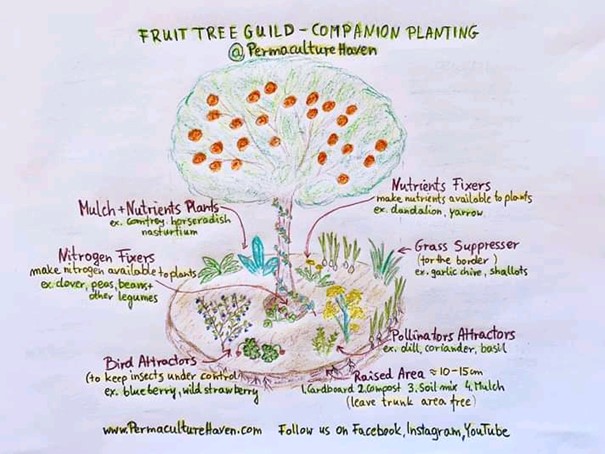LESSON 1.1 INTRODUCING - Strategy for sustainable living.
FOOD FOREST COURSE
AGRO-ECONOMY LESSON 1.1
INTRODUCING - Strategy for sustainable living.
Food Forest gardening is a central practice of
Permaculture and is an ecological design strategy for sustainable living.
Eco systems such as mature rain forests have a huge number of relationships between its component parts. Trees, understory, ground cover, soil, fungi, insects and animals are an integral part of this system. Plants grow at different heights and this allows a diverse community of life to grow in a relatively small space. Plants come into leaf and fruit at different times of year.
Edible forest gardens can mimic the complexity of a
mature ecosystem and can offer inspiring and practical information of perennial
polycultures and of multipurpose plants in small-scale settings. We can apply
the principles of a natural ecology to the design of home gardens that mimic
forest ecosystems to grow our food, fuel, fodder, fertiliser, ‘farmaceuticals,’
and fun. We should begin to learn how to
apply ecological principles to the design of our food production systems and
learn about the complex laws of nature.
We can learn this through designing and creating a food forest
garden. It will be like an outdoor
classroom.
Food forest gardening is also known as three-dimensional gardening. It is a food production and land management system based on replicating woodland ecosystems, but substituting trees with large bushes, shrubs, herbs, vines and vegetables which have yields useful to humans and livestock. By the use of support plants, guilds and companion plants, these can be intermixed to grow on multiple levels in the same area amongst the tropical vegetables, as do the plants in a forest. Based on the observation that the natural forest can be divided into distinct layers or ‘stacking,’ we use inter-cropping to develop a food forest garden.
TEXT TO THE PICTURE:
MULCH & NUTRIENTS PLANTS: Ex. Comfrey, horseradish nasturtium
NITROGEN FIXERS: Make nitrogen available to plants, ex. clover, peas, beans, + other vegetables. Ex. Dandelion, Yarrow.
BIRD ATTRACTORS: (to keep insects under control ex. Blueberry, wild strawberry)
GRASS SUPPRESSOR: (for the border) ex. Garlic chive, shallots
RAISED AREA. 10 – 15 cm. 1.) Cardboard, 2.) compost. 3.) soil mix, 4.) Mulch , leave trunk area free
MORE INFOS: Be more successful with our company as consultant in AGRO-ECONOMY. We reach 4 times more yields, click on the blog: https://atlas-development.blogspot.com
Join in on 150 lessons FOOD FOREST COURSE AGROFORESTRY you can easy start now. Click on https://food-forest-course.blogspot.com THE STANDARD you find there forever.
Find the 250 lessons, the basics of ORGANIC FARMING COURSE in fb on FAIREC forever. https:// www.facebook.com/FAIREC-Atlas-Developement-SARL-654505228040366/
Save daily 50 % water, energy, and fertilizer with us. Use also 2-wheel
tractors for easy and better farming. See 70 lessons of best SUBSURFACE DRIP
IRRIGATION for crops and trees Use our best T-Tape, click on the blog https://smart-farming-solutions.blogspot.com
#organicfarmer #organic #organicfarmingpractices #organicfarming #organicfarm #foodforest #syntropic #agroecology #syntropicfarming #agroeconomy #introductiontopermaculture #permacultureprinciples #creativethinking #permaculturehomesteading #regenerativefuture




Comments
Post a Comment